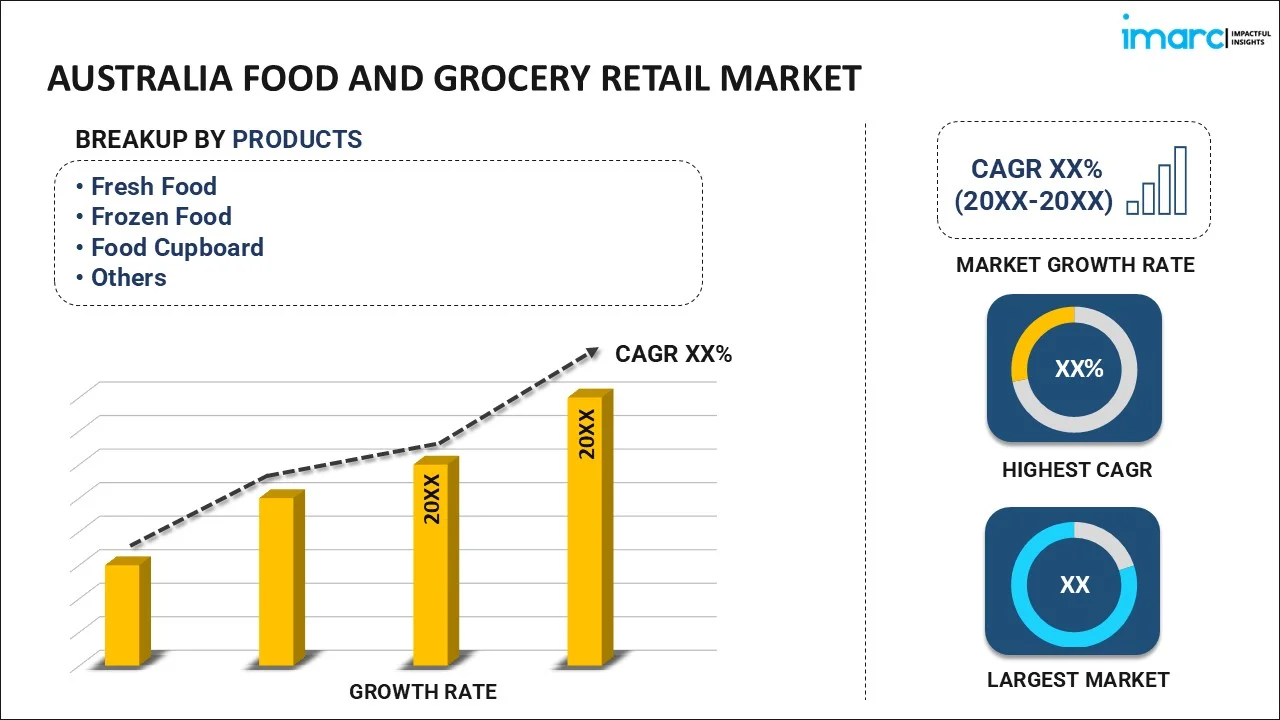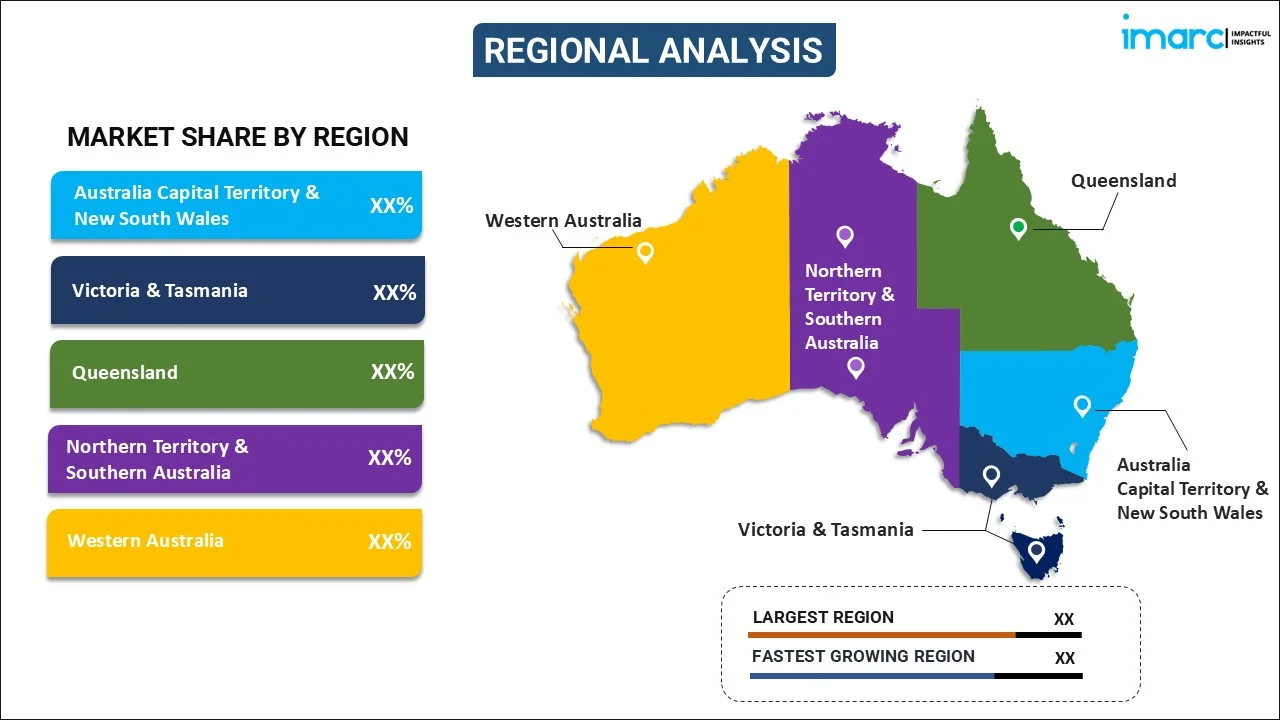
Australia Food and Grocery Retail Market Size, Share, Trends and Forecast by Product, Distribution Channel, and Region, 2025-2033
Australia Food and Grocery Retail Market Overview:
The Australia food and grocery retail market size reached USD 150.11 Billion in 2024. Looking forward, IMARC Group expects the market to reach USD 270.23 Billion by 2033, exhibiting a growth rate (CAGR) of 6.20% during 2025-2033 The market is driven by factors such as changing consumer preferences towards health and wellness, increased focus on sustainability, technological advancements in e-commerce and delivery, demographic shifts with an aging population, and economic conditions impacting disposable incomes and spending patterns.
|
Report Attribute
|
Key Statistics
|
|---|---|
|
Base Year
|
2024
|
|
Forecast Years
|
2025-2033
|
|
Historical Years
|
2019-2024
|
| Market Size in 2024 | USD 150.11 Billion |
| Market Forecast in 2033 | USD 270.23 Billion |
| Market Growth Rate (2025-2033) | 6.20% |
Australia Food and Grocery Retail Market Trends:
Rising Demand for Organic and Health-Conscious Products
One notable trend in the Australian food and grocery retail market is the rising demand for organic and health-conscious products. As consumers become increasingly aware of the health benefits associated with organic foods, retailers are expanding their offerings to include a broader range of organic items across various categories. This shift is also influenced by the growing trend of sustainable and responsible food sourcing practices, with consumers opting for products that not only promote health but also support environmental well-being. Consequently, Australian retailers are enhancing their marketing strategies to highlight organic certifications and the provenance of their offerings, catering to the ever-evolving preferences of health-oriented shoppers. For instance, as per recent industry statistics, the Australian organic market in 2023 reached a value of USD 3.1 Billion, growing 5.4% year-over-year. It directly contributes USD 851 Million to the economy and supports over 12,000 jobs. Key trends include 65% consumer adoption, with top products being fruit, vegetables, dairy, and meat. Certified organic land spans 35.7 Million hectares, and organic exports total USD 750 Million, with the USA, China, and Singapore as primary markets. The sector also has a 30% reduced carbon footprint, and organic viticulture production increased by 4.8%, reaching 18,500 tonnes.
Expansion of Online Grocery Shopping
Another significant trend is the accelerated growth of online grocery shopping and contactless payment solutions. For instance, as per the data by Australian Bureau of Statistics, online retail sales totaled AUD 4.41 Billion (USD 2.82 Billion) in December 2024, up by 4.2% month-on-month, and 12.7% year-on-year. This shift in consumer behavior has driven a rapid adoption of e-commerce platforms for grocery purchases. Retailers are investing heavily in technology to enhance their online shopping interfaces and streamline supply chain logistics, thereby improving customer experience and fulfillment efficiency. Additionally, contactless payment methods have gained prominence, providing consumers with convenience and security during transactions. As a result, traditional brick-and-mortar retailers are developing click-and-collect services and home delivery options, creating a hybrid shopping experience that aligns with the convenience-driven lifestyle of modern consumers while meeting their needs for efficient and reliable purchasing solutions.
Australia Food and Grocery Retail Market Segmentation:
IMARC Group provides an analysis of the key trends in each segment of the market, along with forecasts at the region/country level for 2025-2033. Our report has categorized the market based on product and distribution channel.
Product Insights:

- Fresh Food
- Frozen Food
- Food Cupboard
- Beverages
- Cleaning and Household
- Others
The report has provided a detailed breakup and analysis of the market based on the product. This includes fresh food, frozen food, food cupboard, beverages, cleaning and household, and others.
Distribution Channel Insights:
- Supermarkets and Hypermarkets
- Convenience Stores and Departmental Stores
- Online
The report has provided a detailed breakup and analysis of the market based on the distribution channel. This includes supermarkets and hypermarkets, convenience stores and departmental stores, and online.
Regional Insights:

- Australia Capital Territory & New South Wales
- Victoria & Tasmania
- Queensland
- Northern Territory & Southern Australia
- Western Australia
The report has also provided a comprehensive analysis of all the major regional markets, which include Australia Capital Territory & New South Wales, Victoria & Tasmania, Queensland, Northern Territory & Southern Australia, and Western Australia.
Competitive Landscape:
The market research report has also provided a comprehensive analysis of the competitive landscape. Competitive analysis such as market structure, key player positioning, top winning strategies, competitive dashboard, and company evaluation quadrant has been covered in the report. Also, detailed profiles of all major companies have been provided.
Australia Food and Grocery Retail Market News:
- In February 2025, Instacart and Coles Supermarkets introduced Caper Carts, AI-powered smart trolleys, at Coles’ Richmond Traders location in Melbourne, Australia. These trolleys allow customers to shop, bag, and pay seamlessly. The Caper Carts use AI, cameras, and a built-in scale to track purchases and sync with Coles' Flybuys rewards program. Customers can also access personalized offers, earn points, and view in-store specials. Coles is the first retailer in the APAC region to implement this technology, enhancing the omnichannel shopping experience.
- In July 2024, ALDI Australia launched its "ALDIcore" campaign in partnership with BMF and Ogilvy PR, inviting dedicated shoppers to share their unique experiences for a chance to win three years of free groceries. The campaign celebrates the diversity of ALDI shoppers and their loyalty. Participants can enter by sharing stories on social media using the hashtag #ALDIcore. The initiative highlights the community's passion for ALDI products and shopping methods, making it the supermarket's largest competition yet.
- In August 2024, Woolworths introduced Australia's first digital supermarket trolley, the Scan&Go Trolley, available for trial at its Windsor store. The device allows customers to scan and bag items while tracking their spending in real-time. This innovation enhances convenience, time-saving, and budget control. Scan&Go Trolley complements existing shopping methods, including self-checkout and online services.
Australia Food and Grocery Retail Market Report Coverage:
| Report Features | Details |
|---|---|
| Base Year of the Analysis | 2024 |
| Historical Period | 2019-2024 |
| Forecast Period | 2025-2033 |
| Units | Billion USD |
| Scope of the Report |
Exploration of Historical Trends and Market Outlook, Industry Catalysts and Challenges, Segment-Wise Historical and Future Market Assessment:
|
| Products Covered | Fresh Food, Frozen Food, Food Cupboard, Beverages, Cleaning and Household, Others |
| Distribution Channels Covered |
Supermarkets and Hypermarkets, Convenience Stores and Departmental Stores, Online |
| Regions Covered | Australia Capital Territory & New South Wales, Victoria & Tasmania, Queensland, Northern Territory & Southern Australia, Western Australia |
| Customization Scope | 10% Free Customization |
| Post-Sale Analyst Support | 10-12 Weeks |
| Delivery Format | PDF and Excel through Email (We can also provide the editable version of the report in PPT/Word format on special request) |
Key Questions Answered in This Report:
- How has the Australia food and grocery retail market performed so far and how will it perform in the coming years?
- What is the breakup of the Australia food and grocery retail market on the basis of product?
- What is the breakup of the Australia food and grocery retail market on the basis of distribution channel?
- What are the various stages in the value chain of the Australia food and grocery retail market?
- What are the key driving factors and challenges in the Australia food and grocery retail market?
- What is the structure of the Australia food and grocery retail market and who are the key players?
- What is the degree of competition in the Australia food and grocery retail market?
Key Benefits for Stakeholders:
- IMARC’s industry report offers a comprehensive quantitative analysis of various market segments, historical and current market trends, market forecasts, and dynamics of the Australia food and grocery retail market from 2019-2033.
- The research report provides the latest information on the market drivers, challenges, and opportunities in the Australia food and grocery retail market.
- Porter's five forces analysis assist stakeholders in assessing the impact of new entrants, competitive rivalry, supplier power, buyer power, and the threat of substitution. It helps stakeholders to analyze the level of competition within the Australia food and grocery retail industry and its attractiveness.
- Competitive landscape allows stakeholders to understand their competitive environment and provides an insight into the current positions of key players in the market.
Need more help?
- Speak to our experienced analysts for insights on the current market scenarios.
- Include additional segments and countries to customize the report as per your requirement.
- Gain an unparalleled competitive advantage in your domain by understanding how to utilize the report and positively impacting your operations and revenue.
- For further assistance, please connect with our analysts.
 Inquire Before Buying
Inquire Before Buying
 Speak to an Analyst
Speak to an Analyst
 Request Brochure
Request Brochure
 Request Customization
Request Customization




.webp)




.webp)












